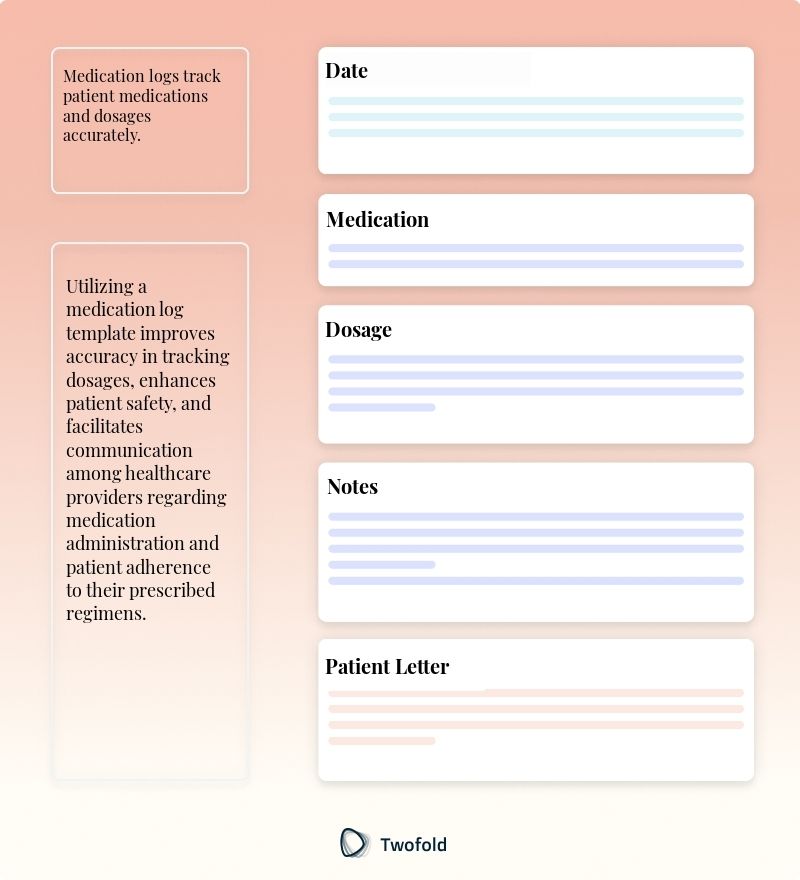
Medication Log Template
Picture this: You're managing a full roster of patients, each with their own complex medication schedules. It's easy to feel overwhelmed trying to keep track of all the scripts, dosages, and refill dates. This is where the Medication Log Template steps in, offering a way to organize and maintain medication records without the headache.
What Is a Medication Log Template?
A Medication Log Template is a structured tool used to document and track patient medication details. It serves as a crucial component in maintaining accurate medical records and ensuring the continuity of care.
This template typically includes fields for medication names, dosages, administration schedules, and any necessary notes on patient reactions or adjustments. With these details, healthcare providers can ensure that patients are adhering to their prescribed regimens.
Key Components of a Medication Log Template
The central elements of a Medication Log Template ensure comprehensive documentation.
- Patient Name and ID
- Medication Name
- Dosage
- Frequency and Timing
- Route of Administration
- Prescribing Doctor
- Notes on Side Effects

How to Use a Medication Log Template: Step-by-Step Process
- Initiate a log entry by filling out the patient identification fields.
- List each medication along with the prescribed dosage.
- Enter the administration schedule, ensuring clear timing instructions.
- Record any changes or updates to medications during follow-up visits.
- Review the log regularly to ensure ongoing accuracy and compliance.
Benefits of a Medication Log Template
Benefit | Description |
|---|---|
Improved Patient Safety | Reduces the risk of medication errors with clear documentation. |
Enhanced Communication | Provides a concise reference for healthcare teams. |
Efficient Record Keeping | Streamlines the process of tracking medication histories. |
Stakeholders in Medication Log Templates
Several key stakeholders benefit from well‑maintained medication logs.
- Doctors: Dr. Smith can use the log to review current medications before prescribing new treatments.
- Nurses: Nurse Jane relies on the log to administer accurate dosages during her shift.
- Pharmacists: John, a pharmacist, checks the log for potential drug interactions before filling prescriptions.
Example of a Medication Log Template
An example could include fields like patient name, list of current medications, dosages, administration times, and special instructions.
Real-World Use Cases: Practical Impact of the Medication Log Template
In practical scenarios, the Medication Log Template can significantly influence patient care.
- Elderly care: A nursing home streamlines communication between staff during shift changes, substantially reducing medication errors.
- Outpatient practices: An outpatient clinic uses medication logs to minimize the risk of adverse drug reactions in multi-medication patients.
- Inpatient facility: A busy hospital ward enhances the efficiency of its rounding process by having up-to-date medication logs readily accessible.
Conclusion
The Medication Log Template proves to be an indispensable tool in healthcare settings, improving documentation standards and reducing errors. By maintaining thorough and accurate medication records, healthcare professionals can provide better patient care and communicate more effectively with their teams. With the right strategies in place, managing complex medication regimens becomes a much more straightforward task.
Disclaimer: This article is for informational purposes only and does not constitute legal or medical advice. Always consult professional guidelines and regulatory bodies for specific compliance requirements.

Dr. Danni Steimberg
Dr. Danni Steimberg is a pediatrician at Schneider Children’s Medical Center with extensive experience in patient care, medical education, and healthcare innovation. He earned his MD from Semmelweis University and has worked at Kaplan Medical Center and Sheba Medical Center.
Medication logs aren’t just lists of drugs—they’re living documents that guide dose adjustments, side‑effect monitoring, and seamless care coordination. Drawn from practical, on‑the‑ground medication management, this approach keeps logs clear and actionable.
- Document Every Adjustment: Note the date, reason, and new dose or frequency to create an error-free, chronological history.
- Capture Patient Feedback: Encourage notes on side effects or symptom changes to spot trends early and adjust treatment faster.
- Coordinate with the Care Team: Consistent, up-to-date logs help ensure a smooth handoff to specialists, pharmacists, or other providers.
Frequently Asked Questions
Reduce burnout,
improve patient care.
Join thousands of clinicians already using AI to become more efficient.

Patient Registration Form Template
Discover practical Patient Registration Form templates to enhance your documentation efficiency.

Therapy Progress Report Template
Discover practical Therapy Progress Report templates to enhance your documentation efficiency.

Patient Notes Template
Discover practical Patient Notes templates to enhance your documentation efficiency.


